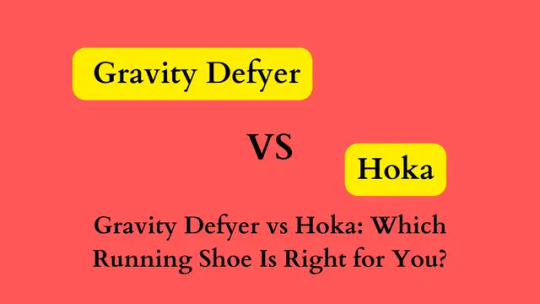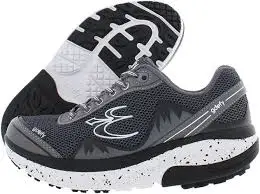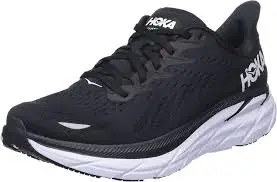#besthokawalkingshoes
Explore tagged Tumblr posts
Text
Gravity Defyer vs Hoka: Which Running Shoe Is Right for You? 2024

Let’s dive into a detailed comparison between Gravity Defyer vs Hoka running shoes. These two brands offer distinct features, so understanding their differences can help you make an informed choice.
Allbirds vs Cole Haan: Which Brand Offers the Best
Gravity Defyer

- Overview: Gravity Defyer was founded in 2008 by Alexander Elnekaveh. The company’s mission is to create athletic and casual shoes that reduce joint pain. - Key Technologies: - VersoShock Trampoline System: This innovative spring system built into the midsole absorbs impact and reduces stress on joints and muscles. - Cradled Insole Design: Provides customized arch support and metatarsal cushioning, helping alleviate foot pain and conditions like plantar fasciitis. - Rocker Sole Design: Encourages a natural gait and proper alignment during walking or running. - Durability: Average outsole durability. - Design & Style: May have a bulky look and is not very stylish. - Popularity: Gravity Defyer is a less popular niche brand. - Best Selling Model: G-Defy Mighty Walk Athletic Sneakers.
Hoka

- Overview: Hoka One One was founded in 2009 by Nicolas Mermoud and Jean-Luc Diard. Their signature feature is the super thick midsoles, providing maximum cushioning for runners. - Key Technologies: - Meta-Rocker Outsole: Encourages a natural gait cycle and smooth transition. - Roomy Toe Box: Allows feet to splay and relax over long distances. - Durability: Excellent outsole durability. - Design & Style: Iconic thick silhouette, but also stylish. - Popularity: Hoka is a very popular mainstream brand. - Best Selling Model: Bondi 8.
Which One Is Better?
- Comfort & Cushioning: - Hoka wins in this category with its pillow-like cushioning, especially over long distances. - Gravity Defyer provides stability, foot, and joint pain relief, making it suitable for those with common foot problems or conditions like plantar fasciitis. - Style & Popularity: - Hoka is more stylish and enjoys widespread popularity. - Gravity Defyer may not be as fashionable but excels in targeted relief and joint protection. - Final Thoughts: - Consider your specific needs and running style before choosing between the two brands. If you prioritize comfort and popularity, go for Hoka. If you need stability and pain relief, Gravity Defyer might be the better choice .
What are the pros and cons of each brand?
Let’s break down the pros and cons of both Gravity Defyer and Hoka running shoes: Gravity Defyer Pros: - Joint Pain Relief: Gravity Defyer shoes are designed to reduce joint pain and impact on your feet. The VersoShock Trampoline System absorbs shock, making them suitable for people with foot conditions like plantar fasciitis. - Stability: The cradled insole design provides good arch support, enhancing stability during movement. - Niche Appeal: If you’re looking for a specialized shoe brand that focuses on comfort and pain relief, Gravity Defyer caters to that niche. Cons: - Style: Gravity Defyer shoes tend to have a bulkier appearance, which may not appeal to those seeking a sleek or fashionable design. - Limited Popularity: The brand is less well-known compared to others in the market. Hoka Pros: - Maximum Cushioning: Hoka shoes are famous for their thick midsoles, offering exceptional cushioning. This makes them ideal for long-distance running. - Meta-Rocker Outsole: The unique outsole design encourages a smooth gait cycle, reducing fatigue during runs. - Roomy Toe Box: Hoka shoes provide ample space for your toes to splay, promoting comfort. Cons: - Thick Silhouette: Some people find the chunky appearance of Hoka shoes less appealing. - Less Support for Specific Conditions: While they offer great cushioning, Hoka shoes may not provide targeted relief for specific foot or joint issues. Conclusion - Hoka is generally recommended for most runners due to its popularity, comfort, and style. - Gravity Defyer is a good choice if you prioritize joint pain relief and stability.
What are the price ranges for both brands?
Let’s compare the price ranges for Gravity Defyer and Hoka running shoes: - Gravity Defyer: - The price range for Gravity Defyer shoes varies based on the model and features. Generally, they range from around ₹6,999 to ₹11,340. - Notable model: G-Defy XLR8 Run. - Hoka: - Hoka shoes offer a wide range of options, from budget-friendly lightweight trainers to premium pairs with advanced technology. - Prices start at under ₹1,000 and can go up to ₹19,999 or more. - Notable models: Carbon X 3, Clifton 8, and Zinal.
Frequently Asked Questions
frequently asked questions (FAQs) related to Gravity Defyer and Hoka running shoes: Q: Are Gravity Defyer shoes suitable for long-distance running? A: While Gravity Defyer shoes provide joint pain relief and stability, they may not be the best choice for long-distance running due to their bulkier design. Consider Hoka for longer runs. Q: What is the key technology behind Hoka shoes? A: Hoka shoes feature a Meta-Rocker Outsole, which encourages a natural gait cycle and smooth transitions during running. Q: Do Hoka shoes have a roomy toe box? A: Yes, Hoka shoes are known for their roomy toe box, allowing your toes to splay comfortably. Q: Which brand is more popular? A: Hoka is more popular and widely recognized in the running community. Q: How much do Gravity Defyer shoes cost? A: Gravity Defyer shoes typically range from around ₹6,999 to ₹11,340. Q: What is the best-selling model for Hoka? A: The Bondi 8 is one of Hoka’s best-selling models. Q: Can I find stylish options in Hoka shoes? A: Yes, Hoka offers stylish designs, especially if you prefer vibrant colors. Q: Which brand provides better cushioning? A: Hoka wins in the cushioning department with its maximum cushioned midsoles. In summary, Hoka tends to have a broader price range, catering to various budgets and preferences, while Gravity Defyer falls within a more specific range. Keep in mind your comfort needs, running style, and budget when making your choice! 🏃���️🏃♀️ Remember, the ideal pair of running shoes depends on your individual preferences and requirements. Happy running! 🏃♂️🏃♀️ Read the full article
#besthokawalkingshoes#gravitydefyer#gravitydefyerreview#gravitydefyerreviews#gravitydefyershoereview#gravitydefyershoes#gravitydefyershoeslegit#gravitydefyershoesreviews#gravitydefyershoesscam#gravitydefyershoeswalmart#gravitydefyerwomen#gravitydefyers#hoka#hokashoesfornurses#hokavsoncloudwhichoneisbetter#hokavsoncloudshoes#isgravitydefyershoeslegit#isgravitydefyershoesscam
0 notes
Text
Are Hoka Shoes Slip Resistant? 2024

Hoka One One, a renowned brand in the running shoe industry, is known for its lightweight and cushioned shoes designed for maximum comfort during runs. But what about slip resistance? Let’s dive into how Hoka crafts slip-resistant shoes and why they could be an excellent choice for your next outdoor adventure.
Hoka’s Slip-Resistant Technology

- Bondi 6 Model: - Hoka makes slip-resistant shoes, and their Bondi 6 model is a prime example. Here’s why it stands out: - Rubber Tread: The Bondi 6 features a rubber tread that provides excellent traction and grip on wet surfaces. - Secure Upper: The shoe’s upper is designed to keep your feet secure. - Cushioned Midsole and Outsole: The midsole and outsole are engineered for cushioning and a smooth ride. - Materials and Technologies: - Hoka utilizes a variety of technologies and materials to enhance slip resistance: - Rubberized Outsoles: These provide extra grip on slippery surfaces. - Textured Midsoles: The midsoles contribute to better traction. - Dynamic Cushioning Systems: These enhance grip on wet and greasy surfaces. - Testing and Certification: - Hoka One One rigorously tests its shoes to ensure slip resistance: - ASTM F2913-15 Standard Test: Measures the coefficient of friction on wet, slippery surfaces. - SATRA TM144 Standard: Evaluates traction on slippery surfaces.
Hoka vs Brooks: Which Running Shoes Are Best for You?
Comparing Hoka with Other Brands
When compared to other brands, Hoka One One shoes are some of the most slip-resistant shoes on the market. Their combination of comfort, cushioning, and excellent grip makes them ideal for those who need reliable footwear in slippery environments.
Hoka’s Slip-Resistant Models
- Bondi SR: - Weight: 14.00 oz - Features: Water-resistant leather and ultra-grippy rubber - Designed for those on their feet all day. - Cavu 3 Slip: - Stability: Neutral with moderate stability - Lightweight EVA midsole for cushioning and support while running. In summary, if you’re looking for slip-resistant shoes that combine comfort and safety, Hoka One One has you covered. Whether you’re hitting the trails or navigating slippery surfaces, their slip-resistant technology ensures you stay surefooted. Happy running! 🏃♀️🏃♂️ References: - Does Hoka Make a Slip Resistant Shoe? - Shoe Effect - Are Hoka Shoes Slip Resistant? - CGAA - HOKA Bondi SR - HOKA ONE ONE® Cavu 3 Slip
Tips for maintaining slip-resistant shoe soles
Certainly! Proper maintenance of slip-resistant shoe soles is essential to ensure their effectiveness in preventing accidents. Here are some tips for keeping your slip-resistant shoes in top condition: - Regular Cleaning: - Importance: Understanding the importance of cleaning slip-resistant shoe soles is crucial. These soles are designed to provide traction and prevent slips, so keeping them clean is essential. - Why Clean?: Over time, soles accumulate dirt, grime, and residue from various surfaces. Without regular cleaning, this buildup can hinder slip-resistant properties, reducing traction and increasing the risk of falls. - Impact of Dirty Soles: Dirty soles compromise the shoe’s ability to maintain proper contact with the ground, diminishing grip and traction. - Cleaning Methods: - Rubbing Alcohol Solution: Mix equal parts of water and rubbing alcohol, then use a cloth to rub the bottom of the shoe sole. This helps break down tough stains and grease. - Toothbrush Scrubbing: For intricate patterns or deep grooves on the sole, a toothbrush can be handy. - Avoid the Washer: - Don’t Put Them in the Washer: Avoid machine washing slip-resistant shoes. Instead, use alternative methods to remove dirt and debris effectively. - Gentle Cleaning: Use a cleaning solution or a mixture of water and mild soap to gently scrub away dirt and grime. - Scuff the Soles: - Purpose: Scuffing the soles adds texture, which helps prevent slipping. - Method: Scuff the soles and heels on concrete or use medium-grit sandpaper or a nail file to create texture. - Temporary Solution: You can also spray the bottom of your shoes with hairspray for a temporary non-slip effect. - Choose the Right Cleaning Method: - Consider the Shoe Material: Different materials may require specific cleaning approaches. - Be Gentle: Avoid harsh chemicals or abrasive methods that could damage the sole material. - Regular Maintenance: Make cleaning part of your routine to maintain slip resistance over time. Remember, slip-resistant shoes are most effective when their soles remain clean and free from debris. By following these tips, you’ll ensure your shoes continue to provide reliable traction and safety in various environments.
Here are some common mistakes people make when caring for slip-resistant shoes.
Certainly! Proper care and maintenance of slip-resistant shoes are essential to ensure their longevity and effectiveness. Here are some common mistakes people make when caring for these shoes, along with tips to avoid them: - Neglecting Regular Cleaning: - Mistake: Failing to clean slip-resistant shoe soles regularly. - Impact: Dirt, grime, and residue accumulate over time, compromising the shoe’s slip-resistant properties. - Tip: Clean the soles using a rubbing alcohol solution or a toothbrush scrubbing method to remove debris effectively. - Machine Washing Slip-Resistant Shoes: - Mistake: Putting slip-resistant shoes in the washing machine. - Impact: Machine washing can damage the shoe’s structure and affect slip resistance. - Tip: Avoid the washer and opt for alternative cleaning methods to preserve the shoe’s effectiveness. - Ignoring Scuffing or Texturing: - Mistake: Not scuffing the soles or heels to add texture. - Impact: Smooth soles reduce grip on slippery surfaces. - Tip: Scuff the soles on concrete or use medium-grit sandpaper to create texture. Alternatively, spray the soles with hairspray for temporary non-slip effect. - Using Harsh Chemicals: - Mistake: Using abrasive cleaners or harsh chemicals. - Impact: Chemicals can damage the sole material. - Tip: Stick to mild soap and water for gentle cleaning. - Not Considering Shoe Material: - Mistake: Applying the same cleaning method to all shoe materials. - Impact: Different materials require specific care. - Tip: Understand the shoe material and choose an appropriate cleaning approach. Remember, slip-resistant shoes perform best when their soles remain clean and free from debris. Avoid these mistakes, and your shoes will continue to provide reliable traction and safety in various environments. Read the full article
#besthokashoes#besthokashoesforwalking#besthokawalkingshoes#hoka#hokarunningshoes#hokashoes#hokashoesreview#latesthokashoesforwalking#mostaccuratehokashoesforwalking#mosthokashoesforwalking#mostrecenthokashoesforwalking#nonslipshoes#nursingshoeshoka#shoes#slipresistant#slipresistantshoes#slipresistantshoesforwomen#slipresistantworkshoes#waterresistantshoes#wherearehokashoesmade
0 notes